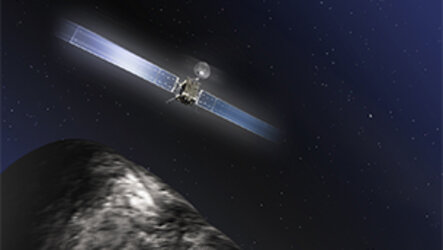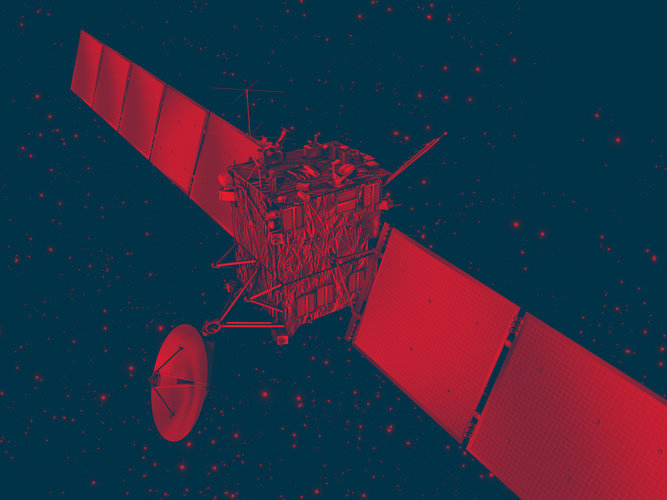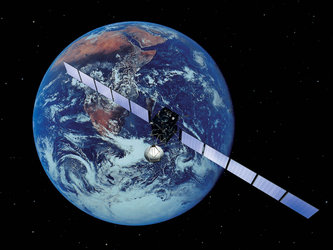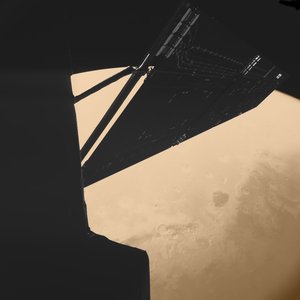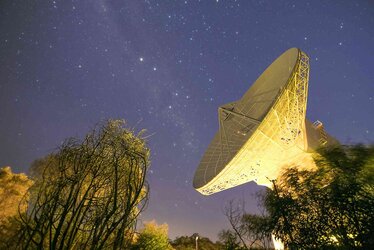Rosetta closes in on Earth – a second time
ESA’s comet chaser, Rosetta, is on its way to its second close encounter with Earth on 13 November. The spacecraft’s operators are leaving no stones unturned to make sure Earth’s gravity gives it the exact boost it needs en route to its destination.
This month’s Earth swing-by is Rosetta’s third major step on its 10-year journey to 67/P Churyumov-Gerasimenko. The trajectory correction manoeuvre successfully performed last month prepared ESA’s Comet Chaser for the upcoming encounter. The spacecraft is now right on track to gain the right amount of energy from Earth’s gravity and save fuel later on.
Closest approach will take place on 13 November 2007 at 21:57 CET, at which time Rosetta will speed past at 45 000 km/h (about 12.5 km/s) relative to Earth. At this time, Rosetta will be 5301km above the Pacific Ocean, south-west of Chile, at 63° 46’ South and 74° 35’ West.
Why swing by Earth?

Swing-bys make use of the gravitational attraction of planets to modify a spacecraft’s trajectory and to gain the orbital energy needed to reach the final target.
The first Earth swing-by took place on 4 March 2005. On 25 February 2007 Rosetta made its closest approach to Mars, to use its gravity. The swing-by this month will be followed by the third and last swing-by, using Earth’s gravity, on 13 November 2009.
While the gravity-assist manoeuvre at Mars was needed to slow the spacecraft down and head back towards the inner solar system, the second Earth swing by will help Rosetta gain enough energy to reach the outer Solar System through the asteroid belt and observe asteroid Steins, one of its scientific targets. Rosetta will then head back to Earth for the last planned swing-by in November 2009.
The increased energy from this Earth swing-by will help Rosetta cross the asteroid belt for a second time, observe Lutetia (its second target asteroid) and finally rendezvous with comet 67/P Churyumov-Gerasimenko. The rendezvous will take place about 4 astronomical units or 600 million km from the Sun, in 2014.
Intense activity coming up...

During this Earth swing-by, the highest priority will be given to spacecraft operations, as the manoeuvre is critical for the success of the overall mission. In addition, during the incoming and outgoing tracks of the swing-by, Rosetta will be under unfavourable solar illumination and thus temperature conditions. This is why only very limited slots will be available for the instruments to be used safely.
Despite this, a few experiments both on the orbiter and the Philae lander will be activated for calibration, scientific measurements and imaging. The observations are scheduled during and around the time of closest approach, from 7 Nov, 01:00 CET, to 20 Nov, 15:00 CET.
Rosetta will first point to Earth to make observations of the atmosphere and the magnetosphere, including a search for shooting stars from space. It will image urban regions in Asia, Africa and Europe and then point to the Moon and obtain spectra of the illuminated Moon. Flying away after closest approach, Rosetta will image the Earth-Moon system from a distance.
Rosetta will be controlled from ESA’s Spacecraft Operations Centre (ESOC) in Darmstadt, Germany
For more detail about Rosetta’s spacecraft and scientific operations, please read the Rosetta second Earth swing-by Q&A.
For the swing-by, the ESA Web portal is hosting a Rosetta swing-by blog providing frequent updates, news and information direct from the Rosetta Dedicated Control Room at ESOC.
Timeline of major activities

Times shown are ground event times in Central European Time, equivalent to UTC (Coordinated Universal Time) + 1 hour
7 Nov
| 1:00 | Start of observations of Earth’s magnetosphere, to be continued until 20 November |
13 Nov
| 1:00 | Start of slew manoeuvre bringing the spacecraft into ‘Earth-pointing’ attitude |
| 21:57 | Closest approach to Earth |
| 22:02 | Start of slew manoeuvre bringing the spacecraft into ‘Moon-pointing’ attitude |
| 23:00 | Start of Moon imaging and observations to be continued until 20 November |
14 November
| 1:45 | Start of first Rosetta data downlink to Earth. There will be a downlink slot each day until 22 November |
| 09:00 | Images on ESA website |
| 11:02 | End of Moon pointing slot |
15 November
| Images of Earth-Moon system from distance |
For more information:
Gerhard Schwehm, ESA Rosetta Mission Manager
Email: Gerhard.Schwehm @ esa.int
Andrea Accomazzo, ESA Rosetta Spacecraft Operations Manager
Email: Andrea.Accomazzo @ esa.int
Rita Schulz, ESA Rosetta Project Scientist
Email: Rita.Schulz @ esa.int



